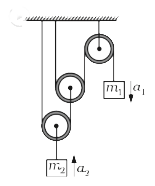Let af and at represent radial and tangential accelerations. The motion of a particle may be circlar, if
(i, iii)
(ii, iii)
(iii, iv)
(ii, iv)
The correct Answer is:C
Step by step video & image solution for Let a_(f) and a_(t) represent radial and tangential accelerations. The motion of a particle may be circlar, if by Physics experts to help you in doubts & scoring excellent marks in Class 12 exams.
Updated on:21/07/2023Topper's Solved these Questions
- RACEBOOK - ALLENCHAPTER - RACEEXERCISE - Basic Maths (COLLISION AND CENTRE OF MASS )
12 Videos
- RACEBOOK - ALLENCHAPTER - RACEEXERCISE - Basic Maths (ROTATIONAL MOTION)
72 Videos
- RACEBOOK - ALLENCHAPTER - RACEEXERCISE - Basic Maths (WORK POWER & ENERGY)
34 Videos
- NEWTONS LAWS OF MOTIONBOOK - ALLENCHAPTER - NEWTONS LAWS OF MOTIONEXERCISE - EXERCISE-III
28 Videos
- SIMPLE HARMONIC MOTIONBOOK - ALLENCHAPTER - SIMPLE HARMONIC MOTIONEXERCISE - Example
1 Videos
Similar Questions
If ar and at represent radial and tangential accelerations, the motion of a particle will be uniformly circular if
View SolutionA particle moves along a circle if radius (20 //pi) m with constant tangential acceleration. If the velocity of the particle is 80m/s at the end of the second revolution after motion has begun the tangential acceleration is .
View SolutionA particle moves along a circle if radius (20/π)m with constant tangential acceleration. If the velocity of the particle is 80m/s at the end of the second revolution after motion has begun the tangential acceleration is .
View SolutionA particle moves along a circle if radius (20 //pi) m with constant tangential acceleration. If the velocity of the particle is 80m/s at the end of the second revolution after motion has begun the tangential acceleration is .
View SolutionA particle moves in a circle with constant tangential acceleration starting from rest. At t = 1/2 s radial acceleration has a value 25% of tangential acceleration. The value of tangential acceleration will be correctly represented by
View SolutionA particle is moving along a circular path ofradius R in such a way that at any instant magnitude of radial acceleration & tangential acceleration are equal. 1f at t = 0 velocity of particle is V0. Find the speed of the particle after time t=(R)/(2V0)
View SolutionA particle is moving on a circle of radius R such that at every instant the tangential and radial accelerations are equal in magnitude. If the velocity of the particle be v0 at t=0, the time for the completion of the half of the first revolution will be
View SolutionGraphs are very useful to represent a physical situation. Various quantities can be easily represented on graphs and other quantites can be determined from the graph. For example the slope of velocity-time graph represents instantaneous acceleration. For a motion with constant acceleration slope of velocity-time graph is constant. If acceleration is changing with time, slope will change and thus velocity-time graph will be a non-linear curve. Further the area of velocity-time graph gives displacement.
The correct relation between v0,a1,a2andt0 is
View SolutionFind the relation between acceleration a1 and a2

View SolutionIf s=aet+be−t is the equation of motion of a particle, then its acceleration is equal to
View Solution
